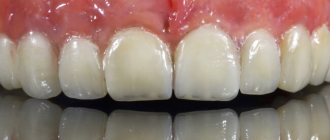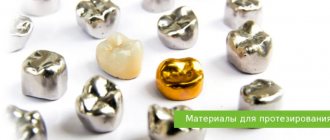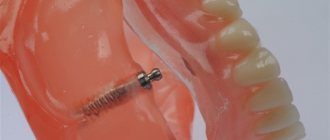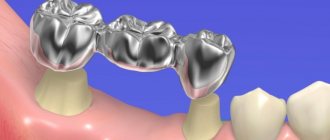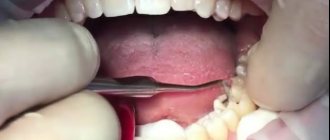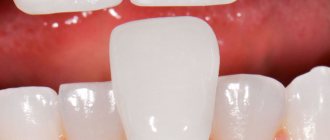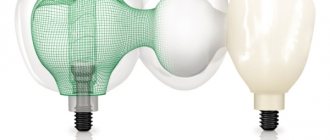A combined crown is a structure consisting of a metal base and a shell. A composite composition, plastic or ceramics is used as an external coating. The color and texture of the shell is matched to the parameters of natural dental elements. The frame is made of stainless steel or alloys of cobalt and chromium, nickel and chromium. The crown is made using stamping or casting. The thickness of stamped dentures is from 0.3 mm. For cast bases, the thickness reaches 0.4-0.5 mm. Frames of the low price segment are created from dental sockets made of stainless steel. A standard sleeve is taken, broached and forged on a die created from an impression from the problem tooth. When making a cast base, an impression is taken from the dental element and a wax model is made. The internal diameter of the correct frame should exceed the diameter of the tooth stump by 50-100 microns. This guarantees the strength of the connection between the microprosthesis and the element. Cast structures have the specified accuracy. Bases for ceramic or composite cladding are made using standard technology. Today, adhesive liquids are used to create a strong bond between the metal substrate and the plastic. The thickness of the surface layer depends on the material and location on the crown (in the cervical, cutting or central part). To prevent the base from showing through the ceramic layer, white varnish or yellow titanium nitride is applied on top. The popularity of prostheses made of gold alloys is due to biocompatibility and lack of translucency. The veneer performs an aesthetic function and is applied to the vestibular surface.
Metal and plastic
These are inexpensive crowns that have been placed on the front teeth for decades.
The metal base was covered with an inert synthetic. But time has shown the conventional aesthetics of the structures - over time, the coating darkened and the metal became visible. After a couple of years, a painful replacement of the prosthesis was required. Today, metal-plastic crowns are cheap and can be used for the restoration of molars. But their aesthetic life is maximum 3 years. Therefore, this option is recommended as temporary. Before permanent prosthetics during implantation or in other cases when it is impossible to install a permanent prosthesis immediately after treatment.
Indications
The use of combined microprostheses is indicated for all dental defects that require a prosthetic procedure. The products are used for units visible when smiling and during speech. We are talking about the frontal units and premolars of the upper jaw.
Combined microprostheses are indicated in the presence of defects:
- Unit mobility.
- Severe destruction of the supragingival part of the element, which is not spread by filling or using inlays.
- Irreversible change in enamel shade.
- Reduced height of the lower third of the face due to increased wear of dental elements.
- Edentia.
Can be used for implantation and other clinical situations.
Zirconium dioxide and ceramics
Such dentures are flawless and are recommended for installation on the front teeth. The units are stronger than natural ones due to the stable zirconium frame, and the ceramic coating gives them a visual naturalness, ensuring correct light reflection.
But such a tooth crown is expensive. And it’s not always justified. Modern solid ceramics are close in strength to natural enamel. Therefore, in most cases, frameless ceramics, which are indistinguishable from natural units, are chosen for the restoration of the beauty area.
In addition, Cerec porcelain crowns for front teeth can be made within 1.5 hours; the price of this option is more affordable and its aesthetics are high. The artificial units created using innovative equipment will be flawless, you don’t need to get used to them - their parameters are calculated by a computer program taking into account the anatomical characteristics of a particular patient.
Materials
Stamped crowns are made from 900 gold or special stainless steel (grade 1x18N9T), which is easy to melt and forge. If the factory stamped sleeve is made of gold, then, due to the softness of this variety, the cutting edge is soldered from a metal of a different standard - harder 750.
But usually gold crowns are no longer placed. And yellow metal crowns, manufactured in modern dental prosthetic workshops, are made by sputtering titanium nitride onto steel blanks, imitating 900 gold.
In addition to steel and gold, blanks made of platinum, an alloy of cobalt and chromium, silver-palladium and titanium can be used.
Metal ceramics
If it is necessary to replace molars, ceramics will not be suitable; the material is too fragile and will not withstand the increased load. Therefore, it is more reasonable to install metal-ceramic or zirconium crowns on chewing teeth. The last segment is more expensive. Therefore, many patients choose a metal cast crown coated with ceramics.
Modern frames are made only by casting. This ensures a tight fit of the crown in the remains of the natural tooth, preventing the entry of pathogenic microflora into the tooth.
Economic factor
stamped crowns are used in the cheapest form of dental prosthetics. They are made from mass-produced industrial metal caps of an average shape, from which a crown imitating a tooth is then made by hammering and stamping.
The thickness of the walls of such a cap is from 0.1 to 0.3 mm, so that, using the appropriate tools, a dental technician can quickly make a crown from it. But it makes sense to do it only if the remainder of the tooth on which it is placed remains at least 1/3 of the original size.
When making an impression of the jaw, the dentist can always recreate on a model the shape of a missing or severely damaged tooth. The dental technician will then use the impression made to make a crown from the blank cap, selecting it according to size.
Alas, modern methods of dental prosthetics are also the most expensive, unaffordable for the vast majority of the population. It is impossible not to have prosthetic teeth. Anyone who is missing even one tooth, let alone several, will confirm that digestive problems very quickly arise due to the inability to fully chew food.
When are combined crowns installed?
Metal-ceramics can be installed if a large tooth crown is destroyed; the frame will protect the remains of the molars from excessive loads.
Metal ceramics are installed:
- For a real tooth with a healthy, strong root that has crumbled by 50% or more.
- As part of the bridge structure - crowns on the supporting teeth.
- As a final prosthesis on implants.
The option is quite worthy for maintaining the function of chewing teeth and helping to preserve the structure of periodontal tissues.
But in general, if a tooth is more than 50 percent damaged, it is more advisable to install a Cerec module, and the tooth restored in this way will serve you for many more years.
How are dentures made?
- Therapeutic treatment of the tooth is carried out after its preparation.
- An impression of both jaws is made using plaster or alginate. Plaster impressions are gradually becoming a thing of the past as obsolete; the use of alginate is preferable.
After this, the dentist begins to work closely in the dental laboratory.
- He is given a model of the dentition of both jaws cast in plaster, on which, in case of problems with the bite, the central relationship for its correction is determined.
- Plaster of Paris is placed in the occluder.
- A plaster stamp is cut out of the wax model that is then created, and then a metal one is made according to its sample.
- The sleeve-blank is selected as precisely as possible according to the size of the cast die.
The fact is that the sleeves are produced according to average parameters, and in order to fit the prepared stamp exactly to the tooth stump, there are two ways: choose the exact size or reduce it from the available ones. The sleeve is put on the second die and the fitting work begins, which includes thermal and mechanical effects on the workpiece.
The final check of the finished crown is done in the clinic, where, after fitting, they look at how tightly it fits (without taking into account the future cement layer) to the neck of the tooth. Defects are identified, then the outer surface is ground. If the patient expresses a desire, titanium nitride will be sprayed onto the steel surface.
At the last stage, the finished crown is dried using alcohol treatment, the cement is diluted and injected inside, and it is forcefully pressed onto the tooth stump. To do this, you just need to clench your jaw tightly. The squeezed out excess cement is removed.
Advantages
Due to the metal base, combined crowns are stronger than real teeth. With proper care, their service life is 15 years
.
Additional advantages:
- They do not lose their shape or shade.
- Visually close to natural enamel. Therefore, they are invisible against the background of neighboring molars when laughing or talking.
- Reliable protection and functionality - you can safely chew your usual food.
- The risk of allergies is minimal (traditionally, up to 2% of people are sensitive to alloys).
When installed correctly, it adheres to the gum and tooth, protecting the units
Crown preparation
Since the crown has walls of a maximum of 0.3 mm (this is practically dense steel foil, with the ability to cut it with scissors), a small amount of dental tissue is prepared. The stump is ground to a cylindrical shape; only on the occlusal surface and in the neck area is the relief maintained according to the location of the enamel.
- The surface is treated with diamond wheels of different diameters, removing a layer of 0.5 mm. A difference of 0.2 mm is made for the use of cement under the crown.
- The distance between the prosthetic tooth and its antagonist on the opposite jaw is constantly checked. To do this, a wax strip test is used, on which, after clenching the teeth, an impression appears, from which the doctor is guided as to the need for modifications to the structure.
- The preparation of the proximal surfaces of the tooth is done - that is, those lateral parts that face the neighbors.
- The buccal and palatal area is treated last, giving the stump the shape of a cylinder. This will make it easier to install the prosthesis and fix it more reliably. The cylindrical surface will also make it possible in the future, when it is time to change the crown, to easily remove it without particularly injuring the stump.
- There should not be a large gap when the edge of the crown touches the dental neck. Ideally, its edge should slightly touch the gum or even sink into it, but no more than 0.3 mm. This will not prevent food debris from getting under the crown, but there will still be less of it than if there was a gap.
The need to replace crowns may arise within 2-4 years. Because no matter how carefully the cement layer is applied, sooner or later aggressive environments from food and saliva, microorganisms, and toxins formed in the mouth overnight will begin to penetrate into the space between the tooth stump and the crown.
The cement itself, under the influence of many factors, gradually breaks down, dissolves and is washed out from under the crown. A gap is formed where food particles get clogged. All this begins to gradually destroy the tooth, either causing caries, or demineralizing it, making it fragile.
Manufacturing and installation of combined crowns
To put a metal-ceramic crown on your teeth (cost – 17,900 rubles / tooth), it will take 7-14 days
.
Manufacturing sequence:
- The tooth is prepared to the thickness of the crown.
- An impression is taken from which a cast crown is made.
- It is advisable to install temporary plastic protection on treated teeth.
- A metal frame is made and tried on.
- If adjustments are needed, they are made, and another fitting follows. When the artificial tooth fits, the metal is coated with ceramic.
- During installation, the tooth is covered with a protective compound, and the prosthesis is fixed with dental cement.
A nuance: the ceramics are applied in layers, each layer is baked in an oven under high temperature. Therefore, the coating is stable and securely attached to the metal base. Contact me at the dentist and we will decide what crown to put on the tooth in your case.
"Advantages and disadvantages"
pros
- The first (and often the decisive) plus is accessibility. The cost can only be compared with plastic products. The average cost of manufacturing and installing one crown without coating (a metal prosthesis without cladding) is about 2,000 rubles in Moscow. With spraying - more than 2200. With different types of linings that hide the metal (linings can be plastic or ceramic) - from 2600 to 5,000.
- The thickness of the walls does not exceed 0.3 mm, which means that, taking into account the additional layer of cement, no more than 0.4 mm is removed from the tooth. That is, depulpation is not performed.
- Speed of production and ease of installation.
- Over the century of use of the method, there are literally isolated cases of rejection of installed crowns as a result of incompatibility of tissues with metals.
Minuses
- Unaesthetic - metal in the mouth, even if it is gold, does not correspond to modern concepts of beauty.
- Insufficient strength of the walls, due to which it quickly grinds down and wears out, allowing infection to penetrate inside.
- Galvanosis is possible - the occurrence of a weak electric current as a result of the impact of acids contained in food and saliva on the metal of the crown.
- The functions of the teeth are not fully restored, and this affects the degree of grinding of food when eating it.
- In cases of “sinks” in the cement layer, aggressive media from food will penetrate to the pulp.
- Anatomical features are not taken into account, which results in incomplete adhesion of the surfaces of opposing teeth.
Manufacturing technology
The manufacturing technology according to Belkin and Pogodin has features, starting from the end of frame manufacturing. First, a stamped base is made using standard technology, then it is modified, which consists of removing part of the metal.
In Belkin’s model, the vestibular part is removed (cut out), while in Pogodin’s design, the vestibular and oral parts are removed. This, on the one hand, prevents metal from being visible through the plastic; on the other hand, it leaves exactly as much metal as is necessary to reinforce the structure and absorb the chewing load .
Starting from the moment of production of stamped MK, the technology for manufacturing structures according to Belkin and Pogodin is as follows:
- Cutting out windows on the vestibular (according to Belkin) and vestibular and oral (according to Pogodin) surfaces of the frame with teeth along the perimeter (for retention). The metal is preserved in the form of bridges in the neck area and covering the cutting or chewing surface of the tooth.
- Installation of the frame on a plaster model, wax modeling.
- Preparation of the plastic mass (mixing powder with liquid).
- Transfer it to a cuvette.
- Packing models in a cuvette with molding sand.
- Wax removal.
- Pressing (filling a cavity with plastic instead of wax). The exact technology is determined by the material used and the equipment available.
- Polymerization of products. Can be done hot or cold depending on the material used.
- Cooling, modification.
The video shows the technique for making a combined crown.
Installation steps
Metal-ceramic models are stopped in two stages:
- Temporary installation (for about a month) to identify negative aspects and errors.
- Permanent fixation.
After the trial period, the crown is removed, the patient is questioned about complaints, and the prosthetic bed and marginal periodontium are examined. If there are no complaints or damage, the microprosthesis is attached to permanent cement.
The glue is mixed thinner than when installing stamped structures. This ensures the necessary fluidity of the cement with small gaps between the crown and the tooth.
Let's figure out together which crowns are best placed on implants and why.
In this publication, we will find out what to do when a gap appears between the crown and the gum.
Here https://zubovv.ru/protezirovanie/nesemnyie-p/koronki-np/plyusyi-i-minusyi-farforovyih.html we will look at the technology for making porcelain crowns.
Reviews
Today, the combined crown can be called “folk” due to its popularity. The time of fashion for gold “fixes” is irrevocably passed.
The main question that worries patients is how long can crowns lined with various materials last? If you have your own experience in this regard, please share it with visitors to our site. The comment form is at the bottom of the page.
If you find an error, please select a piece of text and press Ctrl+Enter.
Tags dental crowns fixed dentures
Did you like the article? stay tuned
Previous article
Teeth analogues from the Japanese company Yamahachi are the best solution for removable prosthetics
Next article
Relevance of neuromuscular dentistry
Life time
The service life of veneered products is determined by several factors, including the type of lining material, the professionalism of the doctor, the accuracy of technology, and care of the oral cavity after prosthetics.
The approximate service life of combined models, depending on the type of cladding, is:
- for metal ceramics – 10-15 years;
- for metal composite products – from 5 to 15 years, depending on the grade (brand) of the composite;
- for metal-plastic structures – up to 5 years.
Failure can occur for various reasons. If for metal-plastic products the main danger is the separation of plastic from the metal, then for composite and ceramic products it is cracks and chips.
While composite products can be repaired in the patient's mouth, with metal ceramics there is no other way to correct the problem other than replacing the crown. The same can be said about metal-plastic microprostheses. Detachment of the lining will inevitably lead to food getting underneath and rotting. Therefore, the sooner the prosthesis is replaced, the better.
Price issue
The cost is determined mainly by the cladding material (not counting products made of precious metals). Depending on it, the price of microprosthetics can range from several to 2 tens of thousand rubles.
The table shows approximate prices for lined structures. But you need to understand that if you want, you can always find an option a couple of thousand cheaper than the market average.
| Type of crown | Cost, rub. | Features of the instructions |
| Metal-plastic | From 2 500 | Frame made of dental socket (stainless steel) |
| Metal composite | From 7 000 | Material GC Gradia or TwiNY |
| Metal-ceramic | From 8 000 | Nickel-chrome alloy frame |
| Metal-ceramic | From 18 000 | Gold frame |
